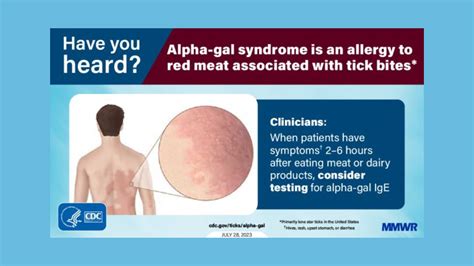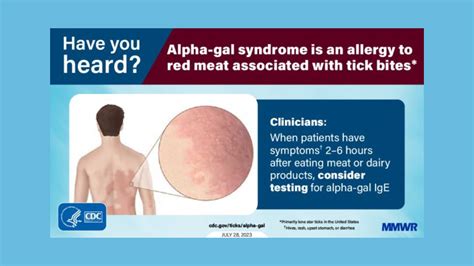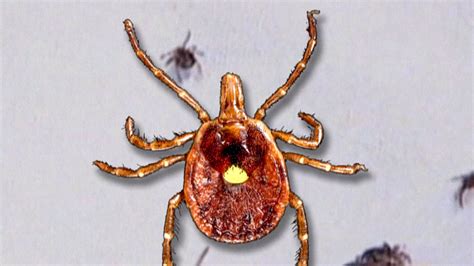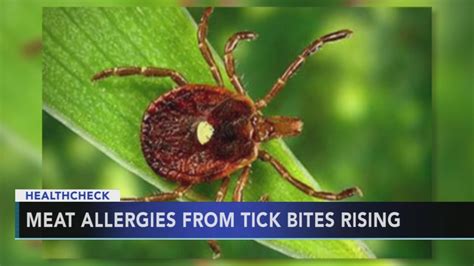Intro
Discover the mysterious link between the Lone Star Tick and a potentially life-threatening meat allergy. Learn how a single tick bite can trigger an immune response, causing red meat allergy symptoms. Explore the science behind alpha-gal allergy, its diagnosis, treatment, and prevention strategies to safeguard your health.
The Lone Star tick, also known as Amblyomma americanum, is a common tick species found throughout the southern and central United States. While it's known to transmit several diseases, including Southern tick-associated rash illness (STARI) and ehrlichiosis, a lesser-known but potentially life-threatening condition associated with the Lone Star tick is the development of a meat allergy.

This condition, also known as alpha-gal allergy, is caused by the tick's saliva, which contains a sugar molecule called galactose-alpha-1,3-galactose (alpha-gal). When a Lone Star tick bites, it injects this molecule into the host's bloodstream, triggering an immune response. In some individuals, this immune response can lead to the development of an allergy to red meat, particularly beef, pork, and lamb.
How Does the Lone Star Tick Cause a Meat Allergy?
The exact mechanism of how the Lone Star tick causes a meat allergy is still not fully understood. However, research suggests that the tick's saliva contains a unique combination of molecules that trigger an immune response in the host. This response leads to the production of antibodies against alpha-gal, which are then stored in the body's immune system.
When an individual with alpha-gal allergy consumes red meat, the alpha-gal molecules in the meat trigger an allergic reaction. This reaction can range from mild symptoms, such as hives and itching, to life-threatening anaphylaxis.
Symptoms of Alpha-Gal Allergy
Symptoms of alpha-gal allergy can vary in severity and may include:
- Hives or itchy skin
- Swelling of the face, lips, or tongue
- Stomach cramps
- Diarrhea
- Vomiting
- Anaphylaxis (severe, life-threatening allergic reaction)

Who is at Risk of Developing Alpha-Gal Allergy?
Anyone can develop alpha-gal allergy after being bitten by a Lone Star tick. However, some individuals are more likely to develop the condition, including:
- People who spend time outdoors, such as hunters, campers, or hikers
- Individuals who live in areas with high Lone Star tick populations
- Those who have a history of tick bites or have been bitten by a Lone Star tick in the past
Diagnosing Alpha-Gal Allergy
Diagnosing alpha-gal allergy can be challenging, as symptoms may not appear until several hours after consuming red meat. A diagnosis is typically made through a combination of:
- Medical history
- Physical examination
- Blood tests to detect alpha-gal antibodies
- Elimination diet (avoiding red meat for a period to see if symptoms resolve)

Managing Alpha-Gal Allergy
While there is no cure for alpha-gal allergy, symptoms can be managed through:
- Avoiding red meat
- Reading food labels carefully to avoid hidden sources of red meat
- Carrying an EpiPen or other emergency medication
- Wearing protective clothing and applying insect repellent when outdoors
Preventing Lone Star Tick Bites
Preventing Lone Star tick bites is the best way to avoid developing alpha-gal allergy. To reduce your risk:
- Wear protective clothing, including long-sleeved shirts and pants
- Apply insect repellent containing DEET, picaridin, or oil of lemon eucalyptus
- Conduct regular tick checks on yourself, children, and pets
- Remove any attached ticks promptly and correctly

Conclusion
The Lone Star tick's association with a meat allergy is a growing concern, particularly in regions with high tick populations. While alpha-gal allergy can be managed through dietary changes and avoidance of red meat, prevention is key. By taking steps to prevent Lone Star tick bites and being aware of the risks, individuals can reduce their likelihood of developing this potentially life-threatening condition.

We hope this article has raised awareness about the Lone Star tick's association with a meat allergy. Share your thoughts and experiences in the comments below!
What is alpha-gal allergy?
+Alpha-gal allergy is a type of food allergy caused by the Lone Star tick's saliva, which contains a sugar molecule called galactose-alpha-1,3-galactose (alpha-gal). This molecule triggers an immune response, leading to an allergy to red meat.
How common is alpha-gal allergy?
+Alpha-gal allergy is a relatively rare condition, but its prevalence is increasing, particularly in regions with high Lone Star tick populations.
Can alpha-gal allergy be cured?
+Currently, there is no cure for alpha-gal allergy. However, symptoms can be managed through dietary changes and avoidance of red meat.
